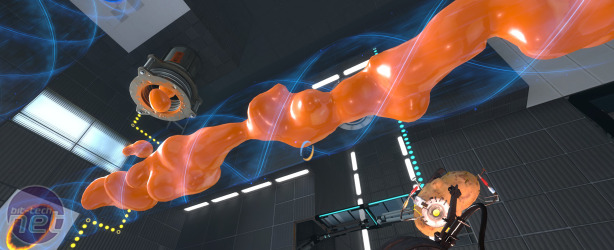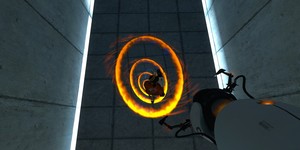
Portal 2 PC Review
Further proving that Portal 2 isn’t just more of the same in a structural and mechanical sense is the addition of new game mechanics, mainly embodied in a series of brightly coloured gels with different properties. Blue gels are imbued with the power of propulsion, allowing them to be used as launch pads and bounce-points. Orange and white gels are used to speed you up and create new portal-friendly surfaces, respectively.Gels aren’t the only new systems to master, however. There are lasers, prisms, hard-light bridges and anti-gravity tunnels. All of these can be manipulated with portals and, while it’s rare to see a test chamber where you can mix and match more than two of them at once, those few levels where these elements do mix stand out as the most interesting and satisfying to solve. Even in smaller chambers and interim areas, it isn’t long before you’re directing floating globules of gel through gravity tunnels and dropping them onto lurking sentries below.
It does have to be said, however, that not all of these systems fit as flushly with the plot as you might expect. The gels especially, while fun, are incongruous to the point of straining the suspension of disbelief.
All of that is much of a muchness though, really. It may seem odd that the same world that elsewhere has Gordon Freeman crowbarring his way through alien menaces here features an orange-overalled woman bouncing around by virtue of blue paint, but that’s also a key part of Portal 2’s appeal. It’s crazed, ingenious and very much tongue in cheek – a fact now better characterised by JK Simmons’ portrayal of Aperture Science CEO, Cave Johnson, than GlaDOS.
It’s also hard to be too dismissive of these new in-game mechanics when they bring so much more content to the game too. By introducing the gels, lasers, bridges and tunnels one by one, then teaching players about them over time, Valve manages to extend Portal 2’s playtime to a decent seven or eight hours, plus co-op. The downside is that this can sometimes feel superfluous to the core plot - Portal 2 would still be great if it was half the length and lacked the gels. The upside is worth it, however: more Portal 2!
The co-operative campaign further adds to the game length too, obviously – where Portal 1 was a bite-sized joy, Portal 2 is more of a main meal. It’s worth pointing out that Valve has made a few decisions that we can’t help but raise cynical eyebrows at, however. The co-operative campaign features an in-game store that lets players buy hats and accessories, for example. This is an idea that Valve has profited from in Team Fortress 2, but which we’ve never been a fan of; the store seems a little too crude to accompany a game as slick as Portal 2.
Further evidence of cynical money grabs show up too, with the addition of a interactive teaser for upcoming film Super 8 looking especially out of place. It’s buried in the extras menu and, to be fair is briefly enjoyable, but does it really need to be there? We’re used to seeing trailers in Activision’s Tony Hawks games, but not so much in the Half-Life franchise.
These little niggles are just that, however; little. Not only is Portal 2’s quality such that it looms over these tiny flaws as a juggernaut of awesomeness, but numerous positive extras further push back the influence of these few weak spots. The developer commentary and in-game version of the Portal 2 comic, to name two.
We can’t ignore that Portal 2 does have a few tiny issues, because it does and they are there. At the same time, we can’t focus on them too much. Portal 2 is a truly fantastic game, a worthy sequel in almost every way and a joy to play. It may not pack the surprise-factor of the original game – a fact which deprives GlaDOS especially of much of her early power – but it’s still just as fun, fast, funny and fantastic as we’d expect a second Portal game to be. It’s a game you should own and one you won’t regret picking up.

-
Overall95 / 100


MSI MPG Velox 100R Chassis Review
October 14 2021 | 15:04











Want to comment? Please log in.